Inferring Phylogenies
Joseph Felsenstein
University of Washington
Sinauer Associates, Inc. • Publishers
Sunderland, Massachusetts
�
COVER: "Far Flung Fir" 27" x 19" x 19" painted plaster over rebar and recycled
styrofoam. Copyright © Joan A. Rudd 1985, exhibited Oregon Biennial 1985, Portland
Art Museum. Collection of the author.
INFERRING PHYLOGENIES
Copyright © 2004 by Joseph Felsenstein
All rights reserved.
This book may not be reproduced in whole or in part without permission
from the publisher. For information or to order, address: Sinauer Associates, Inc.,
PO Box 407,23 Plumtree Road, Sunderland, MA, 01375 U.S.A. FAX: 413-549-1118
Internet: publish@sinauer.com; http://www.sinauer.com
Printed in U.S.A.
543
�
Contents
Preface
1 Parsimony methods
A simple example
.
Evaluating a particular tree
.
Rootedness and unrootedness
Methods of rooting the tree
Branch lengths . . . . .
Unresolved questions . . .
.
2 Counting evolutionary changes
The Fitch algorithm . . .
The Sankoff algorithm . . . .
. . .
. . . . . .
Connection between the two algorithms
. . .
. .
. . . . . . .
Using the algorithms when modifying trees
Views
Using views when a tree is altered
Further economies
.
.
3 How many trees
are there?
Rooted bifurcating trees
Unrooted bifurcating trees
Multifurcating trees ....
Tree shapes
Unrooted trees with multifurcations
.
Rooted bifurcating tree shapes
..
Rooted multifurcating tree shapes
Unrooted Shapes
Labeled histories
Perspective . . .
. . . .
v
xix
1
1
1
4
6
8
9
11
11
13
16
16
16
17
18
19
20
24
25
28
29
29
30
32
35
36
�
vi
4 Finding the best tree
by heuristic search
Nearest-neighbor interchanges
Subtree pruning and regrafting
Tree bisection and reconnection
Other tree rearrangement methods
. . . .
.
Tree-fusing . . . .
Genetic algorithms
Tree windows and sectorial search
. . .
Speeding up rearrangements
Sequential addition
Star decomposition . .
Tree space
Search by reweighting of characters.
Simulated annealing
History
. . .
.
.
.
5 Finding the best tree
by branch and bound
A nonbiological example
Finding the optimal solution.
NP-hardness
.
Branch and bound methods
Phylogenies: Despair and hope
Branch and bound for parsimony
Improving the bound .
. . . .
Using still-absent states.
Using compatibility.
Rules limiting the search
6 Ancestral states
and branch lengths
Reconstructing ancestral states
.
Accelerated and delayed transformation.
Branch lengths . . . . .
. . .
. . . . . . . .
7 Variants of parsimony
Camin-Sokal parsimony
Parsimony on an ordinal scale
Dollo parsimony.
Polymorphism parsimony ..
Unknown ancestral states
..
Multiple states and binary coding.
Dollo parsimony and multiple states
. . .
. .
37
38
41
44
44
44
45
46
46
47
48
50
51
52
53
54
54
57
59
60
60
61
64
64
64
65
67
67
70
70
73
73
74
75
76
78
78
80
�
Polymorphism parsimony and multiple states
.
Transformation series analysis
Weighting characters . . . .
. . .
Successive weighting and nonlinear weighting
. . . . . . . .
Successive weighting .
. .
Nonsuccessive algorithms
8 Compatibility
Testing compatibility
.
The Pairwise Compatibility Theorem .
Cliques of compatible characters ...
Finding the tree from the clique . .
. .
Other cases where cliques can be used
Where cliques cannot be used . . . . .
. . . . . .
. .
Perfect phylogeny.
Using compatibility on molecules anyway.
9 Statistical properties of parsimony
Likelihood and parsimony .
.
Consistency and parsimony . .
. .
. . .
. . ..
. . . . . . .
The weights
.
Unweighted parsimony ....
Limitations of this justification of parsimony
Farris's proofs . . . . .
No common mechanism .....
Likelihood and compatibility ..
Parsimony versus compatibility.
. .
Character patterns and parsimony
Observed numbers of the patterns
Observed fractions of the patterns
Expected fractions of the patterns.
Inconsistency
.
When inconsistency is not a problem .
The nucleotide sequence case . . . .
.
Other situations where consistency is guaranteed
Does a molecular clock guarantee consistency?
The Farris zone
Some perspective . . . .
. . . . . . . . .
.
10 A digression on history and philosophy
How phylogeny algorithms developed.
Sokal and Sneath . . .
. .
Edwards and Cavalli-Sforza ...
Camin and Sokal and parsimony
. . . .
vii
81
81
82
83
83
85
87
88
89
91
92
94
94
95
96
97
97
100
100
101
102
103
105
107
107
107
110
111
111
113
114
115
117
118
120
121
123
123
123
125
129
�
viii
.
.
.
.
.
.
Eck and Dayhoff and molecular parsimony .
.
Fitch and Margoliash popularize distance matrix methods
Wilson and Le Quesne introduce compatibility
Jukes and Cantor and molecular distances ..
Farris and Kluge and unordered parsimony .
Fitch and molecular parsimony
.
Further work.
.
.
What about Willi Hennig and Walter Zimmerman?
. .
.
.
.
.
.
.
.
.
.
.
.
.
.
.
Different philosophical frameworks
H ypothetico-deductive
Logical parsimony
.
Logical probability? .
.
Criticisms of statistical inference
The irrelevance of classification
.
.
.
.
.
11 Distance matrix methods
Branch lengths and times.
.
The least squares methods .
.
.
Least squares branch lengths
Finding the least squares tree topology .
.
.
.
.
.
.
.
The statistical rationale ..
Generalized least squares
Distances
The Jukes-Cantor model-an example
Why correct for multiple changes?
.
.
Minimum evolution.
Clustering algorithms.
. .
UPGMA and least squares .
A clustering algorithm
An example
.
UPGMA on nonclocklike trees.
.
.
Neighbor-joining
.
.
.
.
.
.
.
.
.
Performance .
Using neighbor-joining with other methods
Relation of neighbor-joining to least squares
Weighted versions of neighbor-joining
. .
Other approximate distance methods.
.
.
Distance Wagner method.
.
A related family .
.
Minimizing the maximum discrepancy
Two approaches to error in trees
.
. .
.
.
.
.
.
.
.
.
.
.
.
.
A puzzling formula .
Consistency and distance methods .
.
.
.
.
.
.
.
.
.
.
130
131
133
134
134
136
136
136
138
139
141
142
143
145
147
147
148
148
153
153
154
155
156
158
159
161
161
162
162
165
166
168
169
169
170
171
171
171
172
172
173
174
�
A limitation of distance methods
12 Quartets of species
The four point metric
The split decomposition
Related methods
Short quartets methods.
The disk-covering method
Challenges for the short quartets and DCM methods .
Three-taxon statement methods.
. .
Other uses of quartets with parsimony
Consensus supertrees . . .
.
eighborliness.
. . .
. . . . . . . .
. .
De Soete's search method
Quartet puzzling and searching tree space .
Perspective.
. . . .
. . . . . . .
. . . .
. .
.
13 Models of DNA evolution
Kimura's two-parameter model
Calculation of the distance.
. .
The Tamura-Nei model, F84, and HKY
The general time-reversible model
.
Distances from the GTR model
. .
. . .
. .
. . . . . . .
The general 12-parameter model
..
LogDet distances
. . .
Other distances
Variance of distance.
Rate variation between sites or loci
Different rates at different sites
Distances with known rates . .
Distribution of rates.
. . . . .
Gamma- and lognormally distributed rates
Distances from gamma-distributed rates.
.
Models with nonindependence of sites .
14 Models of protein evolution
. . . . .
. . .
. .
Amino acid models .
The Dayhoff model
.
Other empirically-based models.
Models depending on secondary structure
. . . .
Codon-based models . . . .
. . . . . . . .
Inequality of synonymous and nonsynonymous substitutions
. . . .
Protein structure and correlated change .
. . . .
. . . .
. . .
ix
175
176
177
178
182
182
183
185
186
188
189
191
192
193
194
196
196
198
200
204
206
210
211
213
214
215
215
216
216
217
217
221
222
222
222
223
225
226
227
228
�
x
15 Restriction sites, RAPDs, AFLPs, and microsatellites
Restriction sites
. . . .
. . . . .
. .
. . .
Nei and Tajima's model
.
Distances based on restriction sites
Issues of ascertainment .
Parsimony for restriction sites .
. . .
. .
. .
. . .
Modeling restriction fragments
Parsimony with restriction fragments
RAPDs and AFLPs
. . . . .
The issue of dominance.
Unresolved problems .
.
Microsatellite models .....
The one-step model . . .
Microsatellite distances.
A Brownian motion approximation.
Models with constraints on array size
Multi-step and heterogeneous models
Snakes and Ladders .
Complications .
16 Likelihood methods
Maximum likelihood . . . .
. . .
Anexample
Computing the likelihood of a tree
.
.
Economizing on the computation
Handling ambiguity and error ..
.
Unrootedness
Finding the maximum likelihood tree
Inferring ancestral sequences
Rates varying among sites ..
Hidden Markov models
Autocorrelation of rates
HMMs for other aspects of models
Estimating the states ...
.
Models with clocks
. .
. . . .
Relaxing molecular clocks
Models for relaxed clocks
Covarions
Empirical approaches to change of rates
.
Are ML estimates consistent? ...
Comparability of likelihoods
A nonexistent proof?
A simple proof.
. . . .
. . .
.
230
230
230
233
234
235
236
239
239
240
240
241
241
242
244
246
246
246
247
248
248
249
251
253
255
256
256
259
260
262
264
265
265
266
266
267
268
269
269
270
270
271
�
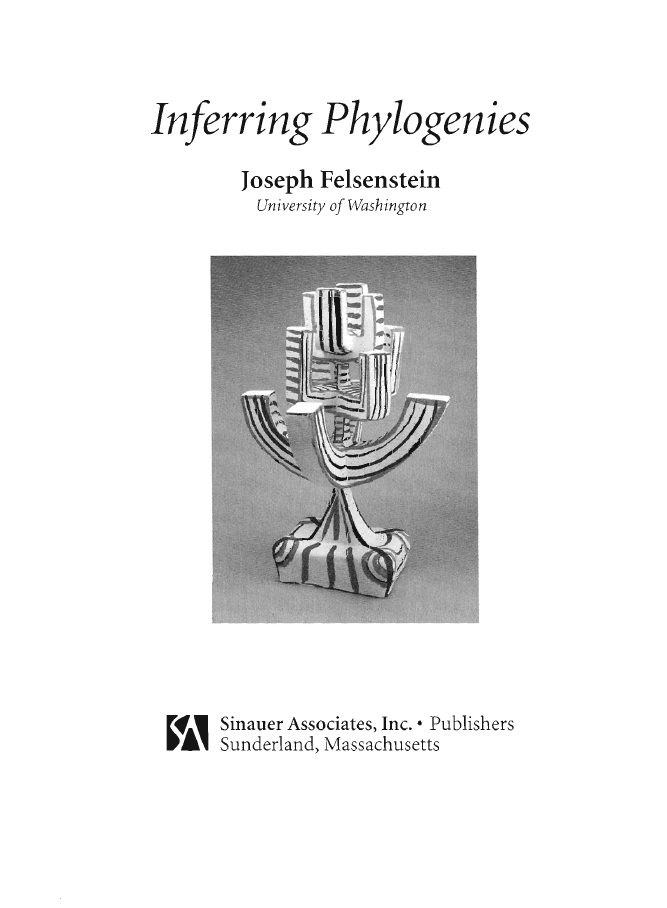
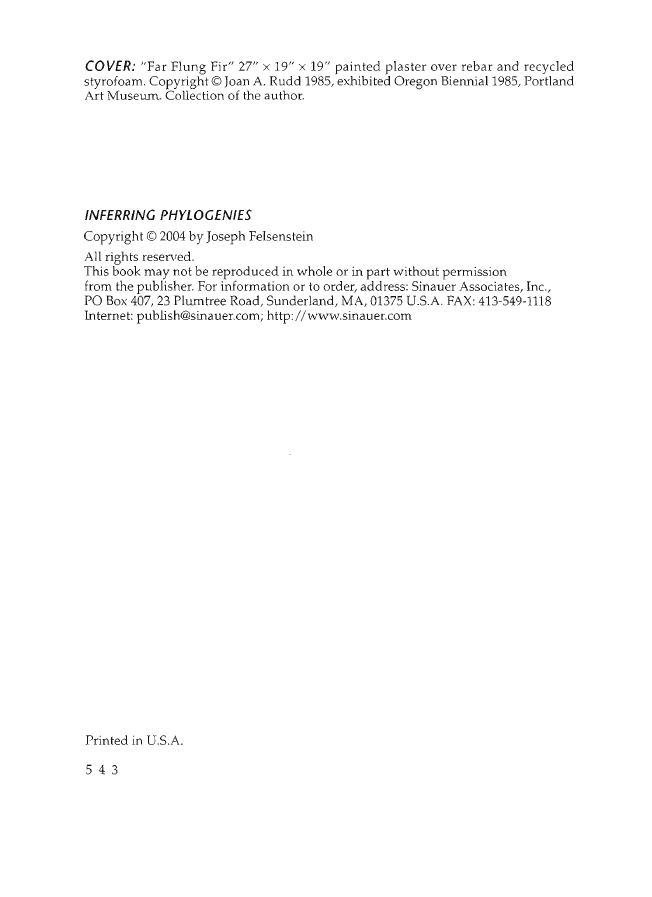
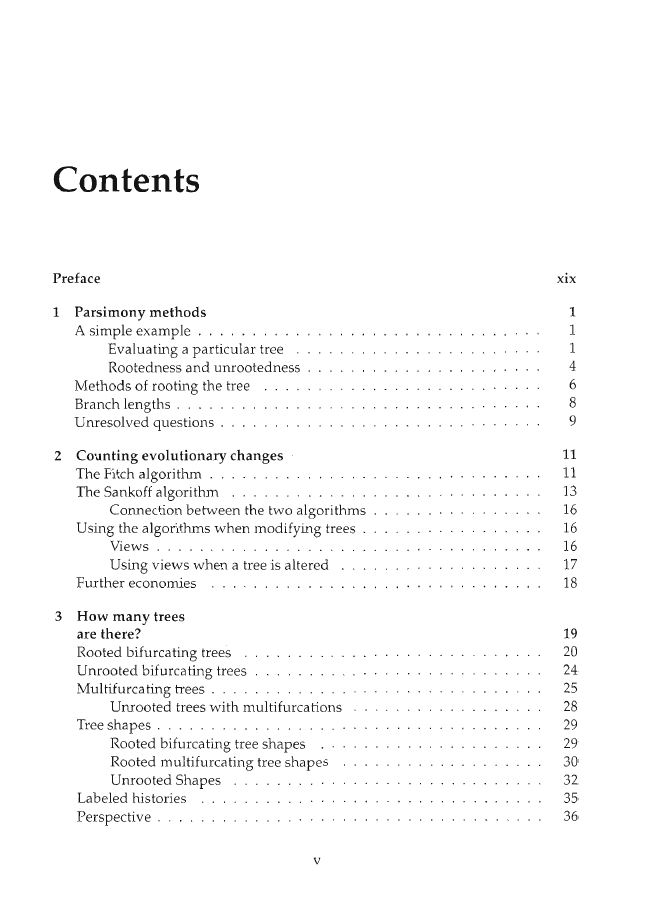
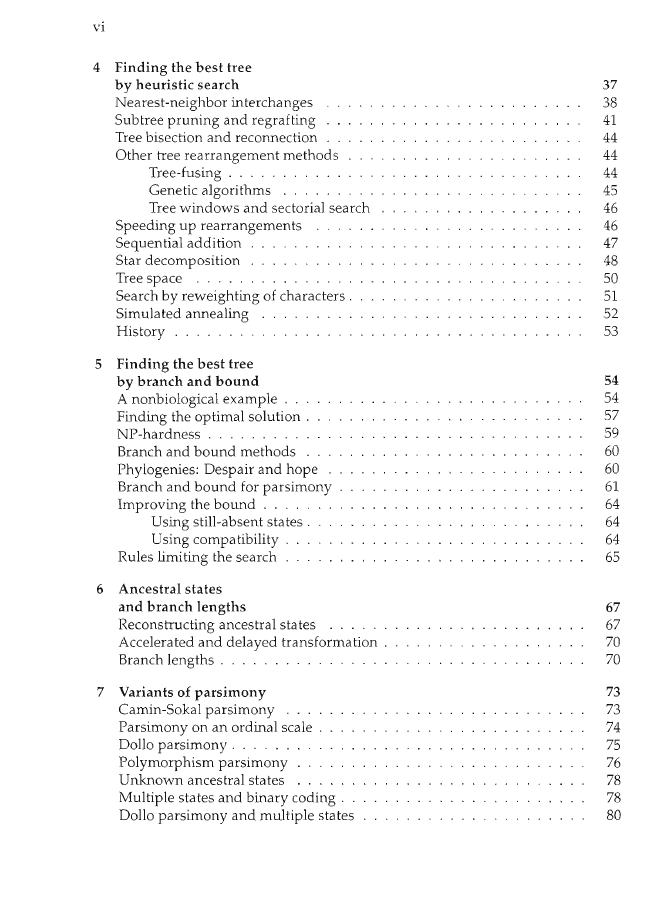
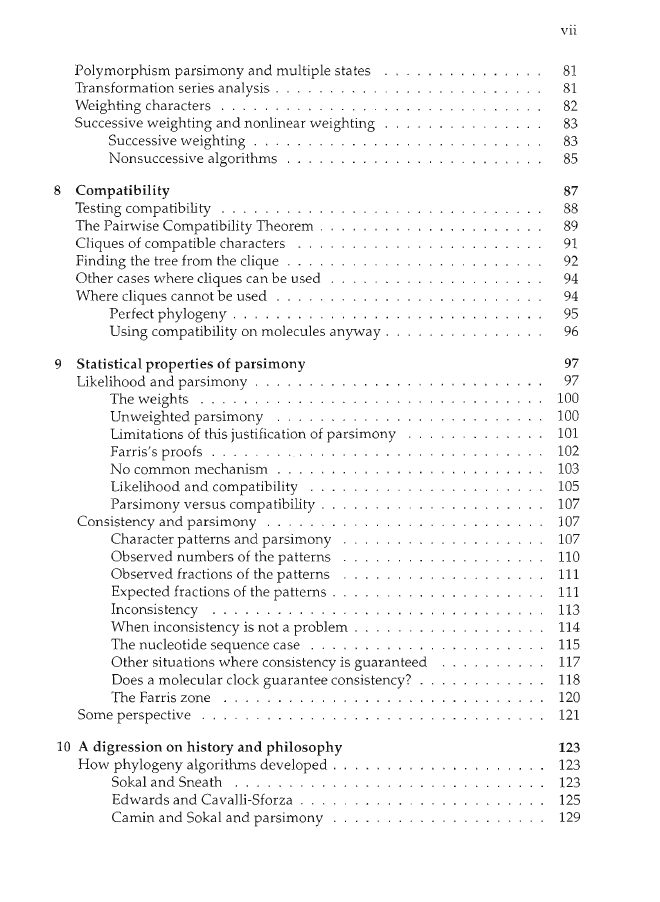
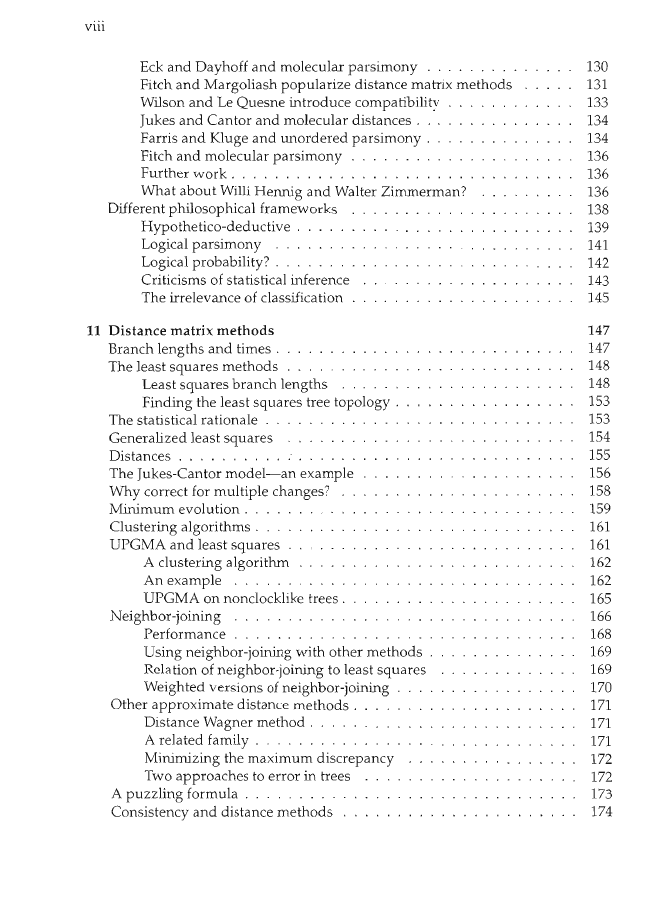
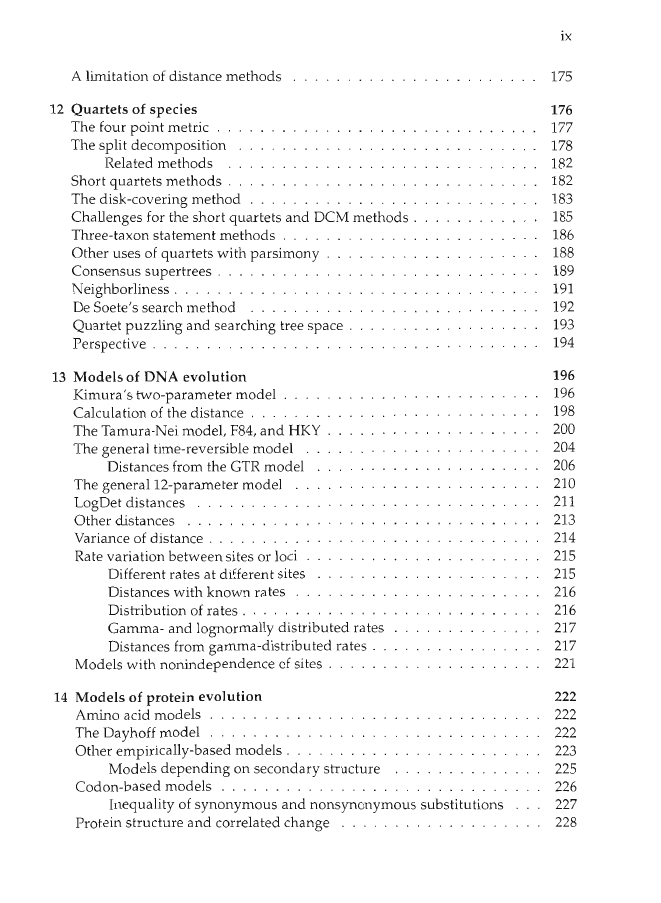









 2023年江西萍乡中考道德与法治真题及答案.doc
2023年江西萍乡中考道德与法治真题及答案.doc 2012年重庆南川中考生物真题及答案.doc
2012年重庆南川中考生物真题及答案.doc 2013年江西师范大学地理学综合及文艺理论基础考研真题.doc
2013年江西师范大学地理学综合及文艺理论基础考研真题.doc 2020年四川甘孜小升初语文真题及答案I卷.doc
2020年四川甘孜小升初语文真题及答案I卷.doc 2020年注册岩土工程师专业基础考试真题及答案.doc
2020年注册岩土工程师专业基础考试真题及答案.doc 2023-2024学年福建省厦门市九年级上学期数学月考试题及答案.doc
2023-2024学年福建省厦门市九年级上学期数学月考试题及答案.doc 2021-2022学年辽宁省沈阳市大东区九年级上学期语文期末试题及答案.doc
2021-2022学年辽宁省沈阳市大东区九年级上学期语文期末试题及答案.doc 2022-2023学年北京东城区初三第一学期物理期末试卷及答案.doc
2022-2023学年北京东城区初三第一学期物理期末试卷及答案.doc 2018上半年江西教师资格初中地理学科知识与教学能力真题及答案.doc
2018上半年江西教师资格初中地理学科知识与教学能力真题及答案.doc 2012年河北国家公务员申论考试真题及答案-省级.doc
2012年河北国家公务员申论考试真题及答案-省级.doc 2020-2021学年江苏省扬州市江都区邵樊片九年级上学期数学第一次质量检测试题及答案.doc
2020-2021学年江苏省扬州市江都区邵樊片九年级上学期数学第一次质量检测试题及答案.doc 2022下半年黑龙江教师资格证中学综合素质真题及答案.doc
2022下半年黑龙江教师资格证中学综合素质真题及答案.doc